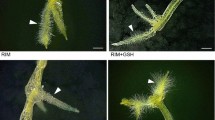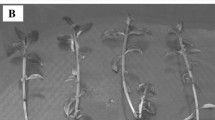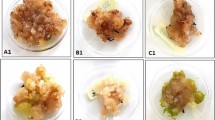Abstract
Vitrification of shoots of Prunus avium L. L. was induced and expressed in a four week in vitro multiplication cycle simply by replacing agar by gelrite. The first vitrification symptoms were visible from the 7th day on. Enzymatic antioxidants were compared weekly in crude extract of normal (on agar) and vitrifying (on gelrite) shoots. The activity of superoxide dismutase was higher in vitrifying shoots. The other enzymes (gaîacol-peroxidase, catalase, ascorbate peroxidase, mono- and dehydro-ascorbate reductases, glutathione reductase) had lower activities. Increased superoxide dismutase activity might mean hydrogen peroxide accumulation and decreased activities of the other enzymes, deficiency in its detoxification. The question therefore is raised whether the hyperhydric morphological abnormalities result from the accumulation of toxic oxygen forms. Vitrification is often considered as a morphological response to several stresses. Contrary to most plants which adapt themselves to stresses by increasing all the above defence enzymes, in vitro shoots under vitrifying conditions appear unable to react in a similar manner.
Similar content being viewed by others
Abbreviations
- Apx:
-
ascorbate peroxidase
- Gpx:
-
gaîacol peroxidase
- CAT:
-
catalase
- H2O2 :
-
hydrogen peroxide
- SOD:
-
superoxide dismutase
- MDHAR:
-
monodehydroascorbate reductase
- DHAR:
-
dehydroascorbate reductase
- GR:
-
glutathione reductase
- MS:
-
Murashige and Skoog (1962)
- IBA:
-
indolebutyric acid
- BAP:
-
benzyladenine
- GA3 :
-
gibberellic acid
References
Arnon D (1949) Copper enzymes in isolated chloroplasts. Polyphenoloxidase in Beta vulgaris. Plant Physiol 24: 1–15
Asada K (1984) Chloroplasts: formation of active oxygen and its scavenging. Methods Enzymol 105: 422–429
Asada K (1992) Production and scavenging of active oxygen in chloroplasts. In: Scandalios JC (ed) Molecular Biology of Free Radical Scavenging Systems, p 173. Cold Spring Harbor Laboratory Press, New York
Bonga JM and VonAderkas P (1992) In Vitro Culture of Trees. Kluwer Academic Publishers, Dordrecht
Bomman CH and Vogelmann TC (1984) Effect of rigidity of gel medium on benzyladenine-induced adventitious bud formation and vitrification in vitro in Picea abies. Physiol Plant: 61: 505–512
Bowler C, VanMontagu M and Inzé D (1992) Superoxide dismutase and stress tolerance. Annu Rev Plant Physiol Plant Mol Biol 43: 83–116
Castillo FJ, Cotton G, Kevers C, Greppin H and Gaspar T (1986) Changes in ascorbic acid content and ascorbate peroxidase activity during the development of Acetabularia mediterranea. Differentiation 33: 17–23
Daguin F and Letouzé R (1985) Relations entre hypolognification et état vitreux chez Salix babylonica en culture in vitro. Rôle de la nutrition ammoniacale. Can J Bot 63: 324–326
Darimont E and Gaspar T (1972) A propos du nombre et du poids moléculaire des isoenzymes peroxydasiques le da racine de Lens culinaris. Soc Bot Fr Mém (Coll Morphol): 221–222
Debergh P, Aitken-Christie J, Cohen D, Grout B, vonArnold S, Zimmerman R and Ziv M (1992) Reconsideration of the term vitrification as used in micropropagation. Plant Cell Tissue Organ Cult 30: 165–140
Gaspar T (1991) Vitrification in micropropagation. In: Bajaj YPS (ed) Biotechnology in agriculture and forestry, Vol 17. High-Tech and Micropropagation I, pp 117–126. Springer-Verlag, Berlin
Gaspar T, Hagège D, Kevers C, Penel C, Crèvecoeur M, Engelmann I, Greppin H and Foidart JM (1991) When plant teratomas turn into cancers in the absence of pathogens. Physiol Plant 83: 696–701
Foyer CH and Halliwell B (1976) The presence of glutathione and glutathione reductase in chloroplasts: a proposed role in ascorbic acid metabolism. Planta 133: 21–25
Halliwell B (1982) Ascorbic acid in the illuminated chloroplast. In: Seib PA and Tolbert BM (eds) Ascorbic acid: chemistry, metabolism, and uses. Advances in chemistry, pp 263–274
Hegedus P and Phan CT (1983) Actions de phénols sur les malformations observées chez les porte-greffes de pommiers M-26 et 0–3 cultivés in vitro. Rev Can Biol Exp 42: 33–38
Hurng WP and Kao CH (1994) Effect of flooding on the activities of some enzymes of activated oxygen metabolism, the levels of antioxidants, and lipid peroxidation in senescing tobacco leaves. Plant Growth Reg 14: 37–44
Kataeva NV, Alexandrova IG, Butenko RG and Dragavtceva EV (1991) Effect of applied and internal hormones on vitrification and apical necrosis of different plants cultured in vitro. Plant Cell Tissue Organ Cult 27: 149–154
Kevers C, Coumans M, Coumans-Gilles MF and Gaspar T (1984) Physiological and biochemical events leading to vitrification of plants cultured in vitro. Physiol Plant 61: 69–74
Kevers C, Prat R and Gaspar T (1987) Vitrification of carnation vitro: Changes in cell wall mechanical properties, cellulose and lignin content. Plant Growth Reg 5: 59–66
Klapheck S, Zimmer I and Cosse H (1990) Scavenging of hydrogen peroxide in the endosperm of Ricinus communis by ascorbate peroxidase. Plant Cell Physiol 31: 1005–1013
Lacoppe J and Hofinger M (1968) A propos d'une méthode colorimétrique d'étude de l'activité catalasique. Bull Soc R Sci Liège 11–12: 605–608
Murashige T and Skoog F (1962) A revised medium for rapid growth and bio-assays with tobacco tissue cultures. Physiol Plant 15: 327–332
Oberley LW and Spitz DR (1985) Nitroblue tetrazolium. In: Greenvald RA (ed) Handbook of methods for oxygen radical research, pp 217–220. CRC Press, Boca Raton FL
Spector T (1978) Refinement of the coomassie blue method of protein quantitation. Anal Biochem 86: 142–146
Winston GW (1990) Physicochemical basis for free radical formation in cells: production and defenses. In: Alscher RG and Cumming JR (eds) Stress responses in plants: Adaptation and acclimation mechanisms, pp 57–86
Zimmerman TW, Rogers SMD, and Cobb BG (1991) Controling vitrification of petunia in vitro. In Vitro Cell Dev Biol 27P: 165–167
Ziv M (1991) Vitrification: morphological and physiological disorders of in vitro plants. In: Debergh PC and Zimmerman RH (eds) Micropropagation. Technology and applications, pp 45–69. Kluwer Academic Publishers. Dordrecht
Author information
Authors and Affiliations
Rights and permissions
About this article
Cite this article
Franck, T., Kevers, C. & Gaspar, T. Protective enzymatic systems against activated oxygen species compared in normal and vitrified shoots of Prunus avium L. L. raised in vitro . Plant Growth Regul 16, 253–256 (1995). https://doi.org/10.1007/BF00024782
Received:
Accepted:
Issue Date:
DOI: https://doi.org/10.1007/BF00024782




